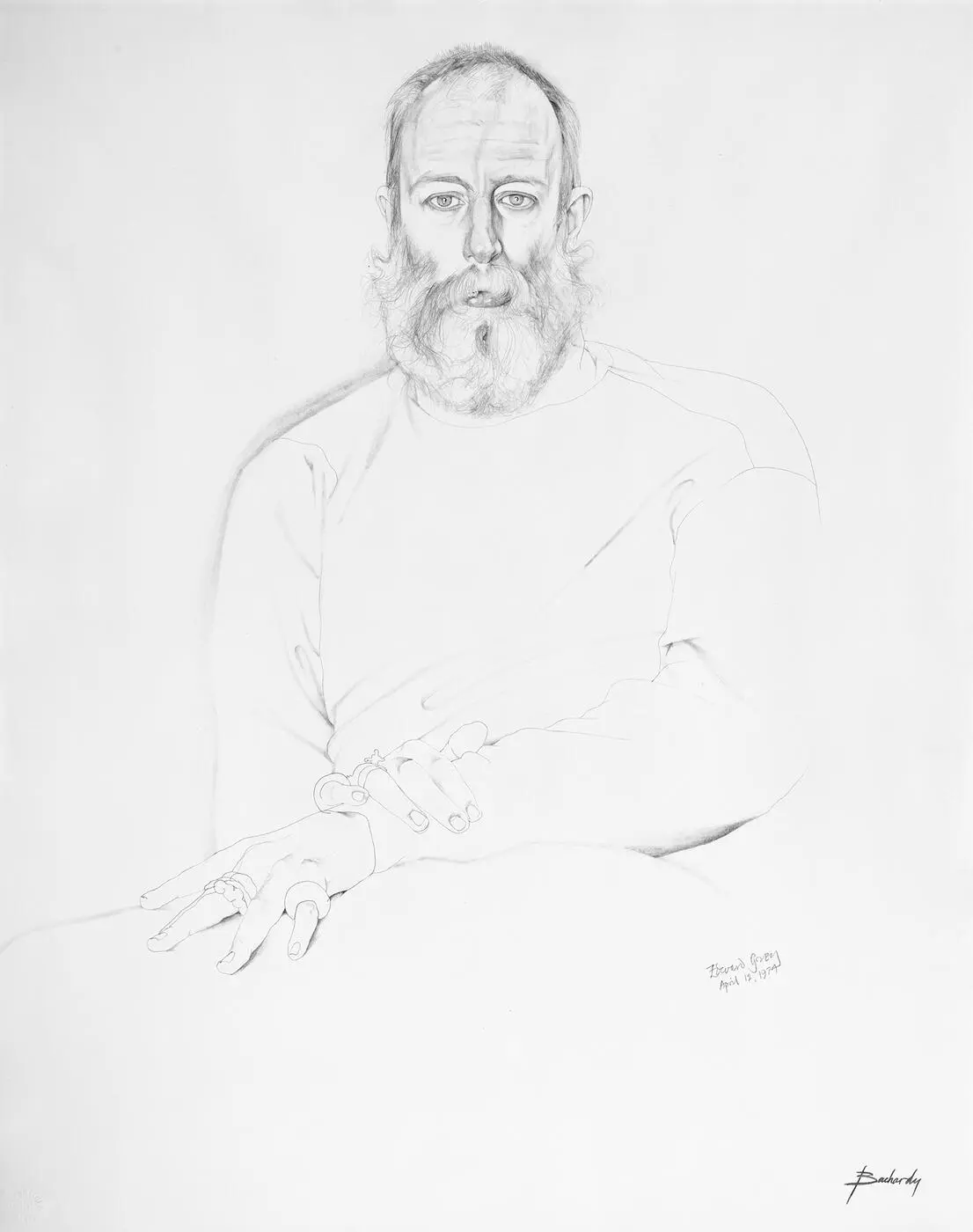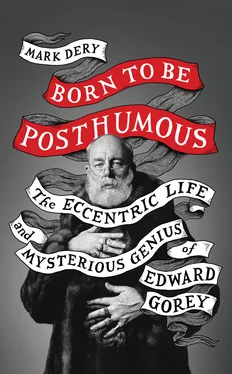
Copyright
William Collins
An imprint of HarperCollins Publishers 1 London Bridge Street London SE1 9GF WilliamCollinsBooks.comThis eBook first published in Great Britain by William Collins in 2018 Copyright © Mark Dery 2018 Mark Dery asserts the moral right to be identified as the author of this work Quotations and excerpts from unpublished correspondence with John Ashbery used in this volume are copyright © 2011 by John Ashbery. All rights reserved. Used by arrangement with Georges Borchardt, Inc., for the author. Illustrations and excerpts from the works of Edward Gorey are used by arrangement with the Edward Gorey Charitable Trust. A catalogue record for this book is available from the British Library Cover design by Jim Tierney Cover photograph by Richard Corman All rights reserved under International and Pan-American Copyright Conventions. By payment of the required fees, you have been granted the non-exclusive, non-transferable right to access and read the text of this e-book on-screen. No part of this text may be reproduced, transmitted, down-loaded, decompiled, reverse engineered, or stored in or introduced into any information storage and retrieval system, in any form or by any means, whether electronic or mechanical, now known or hereinafter invented, without the express written permission of HarperCollins Source ISBN: 9780008329815 Ebook Edition © October 2018 ISBN: 9780008329822 Version: 2018-10-24
For Margot Mifflin, whose wild surmise—“What about a Gorey biography?”—begat this book. Without her unwavering support, generous beyond measure, it would have remained just that: a gleam in her eye. I owe her this—and more than tongue can tell.
Introduction

Don Bachardy, Portrait of Edward Gorey (1974), graphite on paper. (Don Bachardy and Craig Krull Gallery, Santa Monica, California. Image provided by the National Portrait Gallery, Smithsonian Institution.)
EDWARD GOREY WAS BORN to be posthumous. After he died, struck down by a heart attack in 2000, a joke made the rounds among his fans: During his lifetime, most people assumed he was British, Victorian, and dead. Finally, at least one of the above was true.
In fact, he was born in Chicago in 1925. And although he was an ardent Anglophile, he never traveled in England, despite passing through the place on his one trip across the pond. He was, however, intrigued by death; it was his enduring theme. He returned to it time and again in his little picture books, deadpan accounts of murder, disaster, and discreet depravity with suitably disquieting titles: The Fatal Lozenge , The Evil Garden , The Hapless Child . Children are victims, more often than not, in Gorey stories: at its christening, a baby is drowned in the baptismal font; one hollow-eyed tyke dies of ennui; another is devoured by mice. The setting is unmistakably British, an atmosphere heightened by Gorey’s insistence on British spelling; the time is vaguely Victorian, Edwardian, and Jazz Age all at once. Cars start with cranks, music squawks out of gramophones, and boater-hatted men in Eton collars knock croquet balls around the lawn while sloe-eyed vamps look on.
Gorey wrote in verse, for the most part, in a style suggestive of a weirder Edward Lear or a curiouser Lewis Carroll. His point of view is comically jaundiced; his tone a kind of high-camp macabre. And those illustrations! Drawn in the six-by-seven-inch format of the published page, they’re a marvel of pen-and-ink draftsmanship: minutely detailed renderings of cobblestoned streets, no two cobbles alike; Victorian wallpaper writhing with serpentine patterns. Gorey’s machinelike cross-hatching would have been the envy of the nineteenth-century printmaker Gustave Doré or John Tenniel, illustrator of Lewis Carroll’s Alice books. Hand-drawn antique engravings is what they are.
Gorey first blipped across the cultural radar in 1959, when the literary critic Edmund Wilson introduced New Yorker readers to his work. “I find that I cannot remember to have seen a single printed word about the books of Edward Gorey,” Wilson wrote, noting that the artist “has been working quite perversely to please himself, and has created a whole little world, equally amusing and somber, nostalgic and claustrophobic, at the same time poetic and poisoned.”1
That “little world” has won itself a mainstream cult (to put it oxymoronically). Millions know Gorey’s work without knowing it. Whether they noticed his name in the credits or not, Boomers and Gen-Xers who grew up with the PBS series Mystery! remember the dark whimsy of Gorey’s animated intro: the lady fainting dead away with a melodramatic wail; the sleuths tiptoeing through pea-soup fog; cocktail partiers feigning obliviousness while a stiff subsides in a lake. Then, too, every Tim Burton fan is a Gorey fan at heart. Burton owes Gorey a considerable debt, most obviously in his animated movies The Nightmare Before Christmas and Corpse Bride . Likewise, the millions of kids who devoured A Series of Unfortunate Events, the young-adult mystery novels by Lemony Snicket, were seduced by a narrator whose arch persona was consciously modeled on Gorey’s. Daniel Handler—the man behind the nom de plume—calls it “the flâneur.” “When I was first writing A Series of Unfortunate Events,” he says, “I was wandering around everywhere saying, ‘I am a complete rip-off of Edward Gorey,’ and everyone said, ‘Who’s that?’” That was in 1999. “Now, everyone says, ‘That’s right, you are a complete rip-off of Edward Gorey!’”
Neil Gaiman’s dark-fantasy novella Coraline bears Gorey’s stamp, too. A devout fan since childhood, when he fell for Gorey’s illustrations in The Shrinking of Treehorn by Florence Parry Heide, Gaiman has an original Gorey hanging on his bedroom wall, a drawing of “children gathered around a sick bed.”1 Gaiman’s wife, the dark-cabaret singer Amanda Palmer, references Gorey’s book The Doubtful Guest in her song “Girl Anachronism”: “I don’t necessarily believe there is a cure for this / So I might join your century but only as a doubtful guest.”2
His influence is percolating out of the goth, neo-Victorian, and dark-fantasy subcultures into pop culture at large. The market for Gorey books, calendars, and gift cards is insatiable, buoying indie publishers like Pomegranate, which is resurrecting his out-of-print titles. Since his death, his work has inspired a half dozen ballets, an avant-garde jazz album, and a loosely biographical play, Gorey: The Secret Lives of Edward Gorey (2016). Of course, there’s no surer sign that you’ve arrived than a Simpsons homage. Narrated in verse, in a toffee-nosed English accent, and rendered in Gorey’s gloomy palette and spidery line, the goofy-creepy playlet “A Simpsons ‘Show’s Too Short’ Story” (2012) indicates just how deeply his work has seeped into the pop unconscious.
But the leading indicator of Gorey’s influence is his transformation into an adjective. Among critics and trend-story reporters, “Goreyesque” has become shorthand for a postmodern twist on the gothic—anything that shakes it up with a shot of black comedy, a jigger of irony, and a dash of high camp to produce something droll, disquieting, and morbidly funny.
Читать дальше














